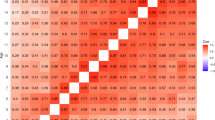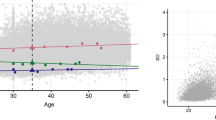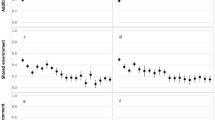Abstract
Increased body mass index (BMI) is a worldwide health issue. Individual differences in the susceptibility to increased BMI could be related to genes or environment. We performed a systematic review of genetic studies on BMI in pre-adolescence, young adulthood and late adulthood. We searched PubMed and EMBASE with heritability, body mass index, BMI, weight, height, anthropometry and twins as search terms. Studies reporting intra-pair correlations of healthy twin pairs that were raised together were included. This resulted in the inclusion of 8,179 monozygotic (MZ) and 9,977 dizygotic (DZ) twin pairs from twelve published studies in addition to individual participant data for 629 MZ and 594 DZ pairs from four twin registries. Structural equation modelling with intra-pair twin correlations showed that the heritability of BMI remained high over all age categories ranging from 61 % (95 % CI 54–64 %) to 80 % (95 % CI 76–81 %) for male and female subjects combined, while unique environmental influences increased from 14 % (95 % CI 13–15 %) to 40 % (95 % CI 37–43 %) with increasing age. Heritability of BMI remains consistently high over different age categories. Environmental changes over time do not seem to have as big a relative impact on an individual’s weight as previously reported, suggesting a mainly genetic influence on variation in BMI over the years.


Similar content being viewed by others
Abbreviations
- A:
-
Additive genetic influences
- BMI:
-
Body mass index
- C:
-
Common environmental influences
- CAATSA:
-
Carolina African American Twin Study of Aging
- DZ:
-
Dizygotic
- E:
-
Unique environmental influences
- EFPTS:
-
East Flanders Prospective Twin Study
- IPD:
-
Individual participant data
- LLTS:
-
Leuven Longitudinal Twin Study
- MTR:
-
Murcia Twin Register
- MZ:
-
Monozygotic
- NTR:
-
Netherlands Twin Registry
- TEDS:
-
Twins Early Development Study
- WHO:
-
World Health Organisation
References
WHO (2011) March 2011 [cited 2012 January 24]. Available from: http://www.who.int/mediacentre/factsheets/fs311/en/.
WHO (2005) The World Health Organization warns of the rising threat of heart disease and stroke as overweight and obesity rapidly increase, in WHO news release: Geneva.
Dietz WH, Gortmaker SL. Do we fatten our children at the television set? Obesity and television viewing in children and adolescents. Pediatrics. 1985;75:807–12.
Cohen D. Obesity and the built environment: changes in environmental cues cause energy imbalances. Int J Obes. 2008;32:S137–42.
Hu F, Li T, Colditz G. Television watching and other sedentary behaviors in relation to risk of obesity and type 2 diabetes mellitus in women. J Am Med Assoc. 2003;289(14):1785–91.
Haworth C, et al. Increasing heritability of BMI and stronger associations with the FTO gene over childhood. Obesity. 2008;16:2663–8.
Lajunen H, et al. Genetic and environmental effects on body mass index during adolescence: a prospective study among Finnish twins. Int J Obes. 2009;33:559–67.
Carmichael C, McGue M. A cross-sectional examination of height, weight, and body mass index in adult twins. J Gerontol Biol Sci. 1995;50A(4):B237–44.
Koeppen-Schomerus G, Wardle J, Plomin R. A genetic analysis of weight and overweight in 4-year-old twin pairs. Int J Obes. 2001;25:838–44.
Schousboe K, et al. Sex differences in heritability of BMI: a comparative study of results from twin studies in eight countries. Twin Res. 2003;6(5):409–21.
Zillikens M, et al. Sex-specific genetic effects influence variation in body composition. Diabetologia. 2008;51:2233–41.
Wisniewski A, Chernausek S. Gender in childhood obesity: family environment, hormones, and genes. Gend Med. 2009;6:76–85.
Boomsma D, et al. Netherlands Twin Register: from twins to twin families. Twin Res Hum Genet. 2006;9(6):849–57.
Whitfield K, et al. Does intact pair status matter in the study of African American twins? The Carolina African American Twin Study of Aging. Exp Aging Res. 2003;29(4):407–23.
Ordoñana J, et al. An initiative in Spain for the study of women’s health: the Murcia Twin Registry. Twin Res Hum Genet. 2006;9(6):865–7.
Beunen G, et al. Univariate and multivariate genetic analysis of subcutaneous fatness and fat distribution in early adolescence. Behav Genet. 1998;28(4):179–288.
Derom C, et al. The east flanders prospective twin survey (EFPTS). Twin Res Hum Genet. 2006;9(6):733–8.
WHO (2010) International Classification of Diseases (ICD). 10th ed.
Haworth C, et al. Increasing heritability of BMI and stronger associations with the FTO gene over childhood. Obesity. 2008;16(12):2663–8.
Haworth C, et al. Childhood obesity: genetic and environmental overlap with normal-range BMI. Obesity. 2008;16(7):1585–90.
Wardle J, et al. Evidence for a strong genetic influence on childhood adiposity despite the force of the obesogenic environment. Am J Clin Nutr. 2008;87:398–404.
Neale M (1999) Mx: statistical modeling 5th ed: Department of Psychiatry, Box 126 MCV, Richmond, VA 23298.
Neale M, Cardon L. Methodology for genetic studies of twins and families. Dordrecht: Kluwer Academic Publishers; 1992.
Sullivan PF, Kendler KS, Neale MC. Schizophrenia as a complex trait: evidence from a meta-analysis of twin studies. Arch Gen Psychiatry. 2003;60(12):1187–92.
Sullivan PF, Neale MC, Kendler KS. Genetic epidemiology of major depression: review and meta-analysis. Am J Psychiatry. 2000;157(10):1552–62.
Harris J, Tambs K, Magnus P. Sex-specific effects for body mass index in the new Norwegian twin panel. Genet Epidemiol. 1995;12:251–65.
Korkeila M, et al. Effects of gender and age on the heritability of body mass index. Int J Obes. 1991;15:647–54.
Silventoinen K, et al. Heritability of body size and muscle strength in young adulthood: a study of one million Swedish men. Genet Epidemiol. 2008;32(4):341–9.
Nelson T, et al. Genetic and environmental influences on body fat distribution, fasting insulin levels and CVD: are the influences shared? Twin Res Hum Genet. 2000;3(1):43–50.
Cardon L, et al. Genetic and environmental correlations between obesity and body fat distribution in adult male twins. Hum Biol. 1994;66(3):465–79.
Faith M, et al. Evidence for independent genetic influences of fat mass and body mass index in a pediatric twin sample. Pediatrics. 1999;104:61–7.
Stunkard A, Foch T, Hrubec Z. A twin study of human obesity. J Am Med Assoc. 1986;256(1):51–4.
Wade T, et al. The influence of genetic and environmental factors in estimations of current body size, desired body size, and body dissatisfaction. Twin Res Hum Genet. 2001;4(4):260–5.
Böttcher Y, et al. Obesity genes: implication in childhood obesity. Occas Rev. 2012;22(1):31–6.
Berulava T, Horsthemke B. The obesity-associated SNPs in intron 1 of the FTO gene affect primary transcript levels. Eur J Hum Genet. 2010;18(9):1054–6.
Hofker M, Wijmenga C. A supersized list of obesity genes. Nat Genet. 2009;41(2):139–40.
Haworth CM, et al. Increasing heritability of BMI and stronger associations with the FTO gene over childhood. Obesity (Silver Spring). 2008;16(12):2663–8.
Pietiläinen K, et al. Genetic and environmental influences on the tracking of body size from birth to early adulthood. Obes Res. 2002;10(9):875–84.
Ortega-Alonso A, et al. Genetic influences on change in BMI from middle to old age: a 29-year follow-up of twin sisters. Behav Genet. 2009;39:154–64.
Nelson M, et al. Body mass index gain, fast food, and physical activity: effects of shared environments over time. Obesity. 2006;14(4):701–9.
Silventoinen K et al. The genetic and environmental influences on childhood obesity: a systematic review of twin and adoption studies. Int J Obes. 2010;34:29–40.
Maes H, Neale M, Eaves L. Genetic and environmental factors in relative body weight and human adiposity. Behav Genet. 1997;27(4):325–51.
Faith M, et al. Parental feeding attitudes and styles and child body mass index: prospective analysis of a gene-environment interaction. Pediatrics. 2004;114:e429–36.
Martínez J, et al. Obesity risk is associated with carbohydrate intake in women carrying the Gln27Glu β2-adrenoceptor polymorphism. J Nutr. 2003;133:2549–54.
Silventoinen K, et al. Genetics of pubertal timing and its associations with relative weight in childhood and adult height: the Swedish Young Male Twins Study. Pediatrics. 2008;121(4):e885–91.
Beunen G, et al. Genetic variance of adolescent growth in stature. Ann Hum Biol. 2000;27(2):173–86.
Rogol A, Clark P, Roemnich J. Growth and pubertal development in children and adolescents: effects of diet and physical activity. Am J Clin Nutr. 2000;72(supplement):521S–8S.
Hur Y-M. Sex difference in heritability of BMI in South Korean adolescent twins. Obesity. 2007;15:2908–11.
Harrington D, Elliott S. Weighing the importance of neighbourhood: a multilevel exploration of the determinants of overweight and obesity. Soc Sci Med. 2009;68:593–600.
Kremers S, et al. Environmental influences on energy balance-related behaviors: a dual-process view. Int J Behav Nutr Phys Act. 2006;3:9.
Pietiläinen K, et al. Physical inactivity and obesity: a vicious circle. Obesity. 2008;16(2):409–14.
Mustelin L, et al. Physical activity reduces the influence of genetic effects on BMI and waist circumference: a study in young adult twins. Int J Obes. 2009;33:29–36.
Acknowledgments
The authors would like to thank Raymond Timmins of the Department of Public Health at the University of Birmingham (UK) for gathering a large part of the papers. This research was funded by the Birmingham Children’s Hospital Research Foundation (BCHRF102f). The MTR is supported by the Seneca Foundation (08633/PHCS/08) and MICINN (PSI11560-2009). LLTS is supported by the Research Fund Katholieke Universiteit Leuven (OT/86/80), National Bank of Belgium, Fund for Medical Research Belgium (3.0038.82, 3.0008.90, 3.0098.91), and North Atlantic Treaty Organisation (860823). This study was previously published in abstract form in Twin Research and Human Genetics (2010): 13(3), p279.
Author information
Authors and Affiliations
Corresponding author
Rights and permissions
About this article
Cite this article
Nan, C., Guo, B., Warner, C. et al. Heritability of body mass index in pre-adolescence, young adulthood and late adulthood. Eur J Epidemiol 27, 247–253 (2012). https://doi.org/10.1007/s10654-012-9678-6
Received:
Accepted:
Published:
Issue Date:
DOI: https://doi.org/10.1007/s10654-012-9678-6




